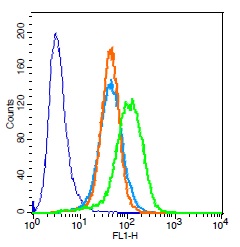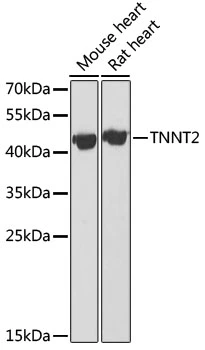![Cardiac Troponin T antibody [1C11] Cardiac Troponin T antibody [1C11]](https://www.genetex.com/upload/website/prouct_img/normal/GTX28295/img12632_w_23060722_972.webp)
Cardiac Troponin T antibody [1C11]
GTX28295
ApplicationsFlow Cytometry, ImmunoFluorescence, Western Blot, ELISA, ImmunoCytoChemistry, ImmunoHistoChemistry, Other Application, Purification/Extraction/Isolation
Product group Antibodies
TargetTNNT2
Overview
- SupplierGeneTex
- Product NameCardiac Troponin T antibody [1C11]
- Delivery Days Customer9
- Application Supplier Note*Optimal dilutions/concentrations should be determined by the researcher.Not tested in other applications.
- ApplicationsFlow Cytometry, ImmunoFluorescence, Western Blot, ELISA, ImmunoCytoChemistry, ImmunoHistoChemistry, Other Application, Purification/Extraction/Isolation
- CertificationResearch Use Only
- ClonalityMonoclonal
- Clone ID1C11
- ConjugateUnconjugated
- Gene ID7139
- Target nameTNNT2
- Target descriptiontroponin T2, cardiac type
- Target synonymsCMD1D, CMH2, CMPD2, LVNC6, RCM3, TnTC, cTnT, troponin T, cardiac muscle, cardiomyopathy, dilated 1D (autosomal dominant), cardiomyopathy, hypertrophic 2, troponin T type 2 (cardiac)
- HostMouse
- IsotypeIgG1
- Protein IDP45379
- Protein NameTroponin T, cardiac muscle
- Scientific DescriptionThe protein encoded by this gene is the tropomyosin-binding subunit of the troponin complex, which is located on the thin filament of striated muscles and regulates muscle contraction in response to alterations in intracellular calcium ion concentration. Mutations in this gene have been associated with familial hypertrophic cardiomyopathy as well as with dilated cardiomyopathy. Transcripts for this gene undergo alternative splicing that results in many tissue-specific isoforms, however, the full-length nature of some of these variants has not yet been determined. [provided by RefSeq, Jul 2008]
- Storage Instruction2°C to 8°C
- UNSPSC12352203
References
- Saito Y, Nose N, Iida T, et al. In vivo tracking transplanted cardiomyocytes derived from human induced pluripotent stem cells using nuclear medicine imaging. Front Cardiovasc Med. 2023,10:1261330. doi: 10.3389/fcvm.2023.1261330Read this paper
- Saito Y, Nakamura K, Yoshida M, et al. Enhancement of pacing function by HCN4 overexpression in human pluripotent stem cell-derived cardiomyocytes. Stem Cell Res Ther. 2022,13(1):141. doi: 10.1186/s13287-022-02818-yRead this paper
- Xu Y, Rothe R, Voigt D, et al. Convergent synthesis of diversified reversible network leads to liquid metal-containing conductive hydrogel adhesives. Nat Commun. 2021,12(1):2407. doi: 10.1038/s41467-021-22675-2Read this paper
- Hoffman RM, Amoh Y. Beating Heart Cells from Hair-Follicle-Associated Pluripotent (HAP) Stem Cells. Methods Mol Biol. 2018,1842:241-254. doi: 10.1007/978-1-4939-8697-2_18Read this paper
- Hoffman RM. Human Hair Follicle Associated-Pluripotent (hHAP) Stem Cells Differentiate to Cardiac Muscle Cells. Methods Mol Biol. 2019,1879:385-392. doi: 10.1007/7651_2018_170Read this paper
- Williams AL, Khadka V, Tang M, et al. HIF1 mediates a switch in pyruvate kinase isoforms after myocardial infarction. Physiol Genomics. 2018,50(7):479-494. doi: 10.1152/physiolgenomics.00130.2017Read this paper
- Lao S, Xu J, Liu Y, et al. A comparative study of the influence of two types of PHEMA stents on the differentiation of ASCs to myocardial cells. Mol Med Rep. 2017,16(1):507-514. doi: 10.3892/mmr.2017.6680Read this paper
- Shirai K, Hamada Y, Arakawa N, et al. Hypoxia Enhances Differentiation of Hair Follicle-Associated-Pluripotent (HAP) Stem Cells to Cardiac-Muscle Cells. J Cell Biochem. 2017,118(3):554-558. doi: 10.1002/jcb.25734Read this paper
- Yashiro M, Mii S, Aki R, et al. Protocols for Efficient Differentiation of Hair Follicle-Associated Pluripotent (HAP) Stem Cells to Beating Cardiac Muscle Cells. Methods Mol Biol. 2016,1453:151-9. doi: 10.1007/978-1-4939-3786-8_16Read this paper
- Yamazaki A, Hamada Y, Arakawa N, et al. Early-age-dependent selective decrease of differentiation potential of hair-follicle-associated pluripotent (HAP) stem cells to beating cardiac-muscle cells. Cell Cycle. 2016,15(19):2619-2625.Read this paper






